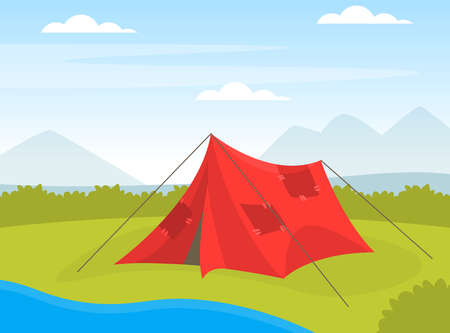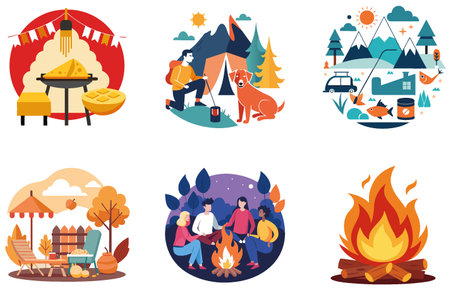Introduction: The Importance of Camping Safety for Kids
Spending time outdoors is a cherished part of American family life, from summer campouts under the stars to weekend hikes in scenic national parks. But before any adventure begins, teaching kids camping safety and basic wilderness skills is essential for both fun and wellbeing. Nature can be unpredictable—whether it’s sudden weather changes, unfamiliar plants and animals, or simply getting turned around on a forest trail. While these challenges may sound daunting, they’re also powerful opportunities for learning and growth. By helping children understand the “why” behind wilderness rules—like staying within sight of adults or recognizing poison ivy—we empower them to explore with confidence and curiosity. Instilling these habits early not only prevents accidents but also fosters independence, teamwork, and a lifelong respect for nature. In American settings where diverse landscapes offer everything from lush forests to arid deserts, preparing kids through engaging games transforms safety lessons into memorable, hands-on experiences that stick long after the campfire fades.
Game-Based Learning: Making Safety Fun and Memorable
When it comes to teaching kids about camping safety and wilderness skills, interactive games are a game-changer—literally. By blending play with essential lessons, children become active participants in their own learning journey, making each skill memorable and fun. In the American context, where outdoor adventure is part of growing up, using games not only keeps kids engaged but also helps them absorb information more effectively compared to traditional lectures or worksheets.
Games naturally spark curiosity and excitement. Whether it’s a scavenger hunt for safe campsite items or a role-play scenario on responding to wildlife encounters, these activities encourage hands-on learning. Kids get to practice real-life situations in a safe environment, which builds both confidence and competence. They learn how to identify hazards, react appropriately in emergencies, and understand the importance of following safety rules—all while having a blast with their peers.
Benefits of Interactive Games in Teaching Camping Safety
| Benefit | Description |
|---|---|
| Active Engagement | Games capture attention, turning lessons into experiences rather than chores. |
| Confidence Building | Practicing skills in low-stress settings empowers kids to handle real-world challenges. |
| Teamwork & Communication | Group games foster cooperation, teaching kids how to work together and communicate effectively—essential for any camping trip. |
| Memorability | Fun activities create lasting memories, helping safety messages stick long after the game is over. |
| Problem-Solving Skills | Games often require quick thinking and decision-making, preparing kids for unexpected situations outdoors. |
Cultivating Life Skills Beyond Camping
The benefits go far beyond the campsite. Kids who engage in these interactive learning experiences develop life skills such as leadership, empathy, and adaptability. These are qualities that serve them well not only in the wilderness but also at home, school, and within their communities. When children feel empowered by what they’ve learned through play, they’re more likely to step up as leaders or helpful teammates during future outdoor adventures.

3. Leave No Trace Relay
If you’re searching for a fun, interactive way to instill respect for nature in kids, the Leave No Trace Relay is a must-try game. Rooted in American outdoor ethics, this activity transforms environmental stewardship into an engaging team challenge—perfect for young campers eager to learn hands-on. The relay is designed around the core principles of Leave No Trace, which emphasize minimizing human impact and caring for wild spaces.
How the Game Works
Divide the kids into small teams and set up several “stations” along a short trail or open area. Each station represents a different Leave No Trace principle, such as packing out trash, respecting wildlife, or staying on marked trails. At each stop, teams complete quick tasks—like sorting recyclables from landfill items, identifying safe campsites, or role-playing wildlife encounters. The aim? To complete the course while demonstrating responsible choices at every turn.
Why It Matters
This relay doesn’t just get kids moving—it sparks thoughtful conversations about how their actions affect the environment. Through playful competition and teamwork, children practice eco-friendly habits that stick long after the game ends. They’ll learn to see themselves as caretakers of nature, not just visitors.
Pro Tip for Leaders
Add a storytelling element by sharing real-life examples of good (and not-so-good) campsite behavior at each station. This localizes the experience and encourages kids to reflect on how they can make a positive difference whenever they venture outdoors.
4. Campfire Safety Simulation
For many kids, the campfire is the heart of the camping experience—crackling logs, glowing embers, and stories under the stars. But before anyone strikes a match, it’s essential to know how to build, maintain, and extinguish a fire safely. The Campfire Safety Simulation is a hands-on learning game designed to teach children about U.S. park fire regulations and responsible practices in an engaging, memorable way.
How the Game Works
This simulation can be played indoors or outdoors using props such as colored paper “flames,” stones for the fire ring, and real campfire tools (unlit for safety). Kids are divided into small teams and assigned roles like Fire Builder, Safety Monitor, and Fire Extinguisher. Each team must “build” a safe campfire following step-by-step guidance from a leader or facilitator.
Simulation Steps and Learning Objectives
| Step | Activity | Key Takeaway |
|---|---|---|
| 1. Site Selection | Teams choose an appropriate spot, clear debris, and set up a rock ring. | Never build fires near overhanging branches or dry grass; always use designated areas. |
| 2. Fire Building Basics | Arrange tinder, kindling, and logs using paper props. | Understand the structure of a safe fire; keep fires small and manageable. |
| 3. Rules & Regulations Quiz | Answer questions about U.S. National Park fire policies (e.g., burn bans). | Aware of local regulations before lighting any fire. |
| 4. Campfire Safety Drill | Pretend to light the fire; practice maintaining distance and handling emergencies. | No horseplay around fire; always have water or sand nearby. |
| 5. Extinguishing Practice | Simulate dousing the “fire” with water and stirring ashes until cool. | The fire must be cold to the touch before leaving site. |
Why This Game Matters
This playful yet practical simulation gives kids confidence in their outdoor skills while reinforcing respect for nature—and community safety. By making each step interactive and collaborative, children absorb vital information about U.S. park guidelines and develop habits that last long after summer camp ends.
5. Wilderness First-Aid Scavenger Hunt
Transforming first-aid learning into a hands-on scavenger hunt brings both excitement and essential knowledge to your camping adventure. In this game, kids set out on a quest to discover common items found in American wilderness first-aid kits—think bandages, antiseptic wipes, tweezers, and emergency blankets. Each item is hidden around your campsite or along a safe trail, accompanied by simple scenario cards that describe minor injuries like scrapes, insect bites, or twisted ankles. As children find each item, they’re encouraged to match it with the correct response card, practicing what to do in real-life situations. This interactive approach not only demystifies first-aid supplies but also empowers young campers with the confidence to recognize and respond calmly to minor emergencies in the wild. The scavenger hunt naturally sparks teamwork and communication as kids help each other search and discuss solutions, all while soaking up the fresh air and beauty of the outdoors.
6. Navigation Challenge: Map and Compass Quest
Introducing kids to navigation skills doesn’t have to be intimidating—it can actually be a fun and memorable adventure! The Map and Compass Quest game is designed to help children learn the basics of map-reading, compass use, and recognizing common US trail markers, all while exploring the outdoors in a safe and engaging way. This interactive activity transforms learning into a playful treasure hunt, fostering both independence and confidence in young explorers.
How the Game Works
Start by dividing the group into small teams and giving each team a simple topographic map of your camping area along with a basic compass. Beforehand, set up “checkpoints” around your site using classic American trail symbols—like blazes, cairns, or colored ribbons—that mirror what kids might see on real hiking trails. Each checkpoint will hold a clue or a small reward, encouraging kids to keep moving forward.
Map-Reading Made Easy
Teach children how to interpret map legends, scale, and orientation by showing them where they are on the map in relation to major landmarks—like a nearby lake, trailhead, or campground. Encourage them to look for natural features and match these with symbols on their map as they navigate from one checkpoint to another.
Getting Comfortable with the Compass
Guide kids through the basics of using a compass: finding north, setting bearings, and following directions. Incorporate mini-challenges that require them to walk in certain directions for specific distances—helping them practice pacing and spatial awareness. These foundational skills will empower them to move confidently even when technology isn’t available.
Recognizing US Trail Markers
Along the route, introduce children to standard US trail markers such as painted blazes on trees (white for the Appalachian Trail), stacked rocks (cairns), or colored arrows. Pause at each marker to discuss its meaning and importance in keeping hikers oriented and safe. This local knowledge not only grounds kids in American outdoor culture but also prepares them for real-life adventures beyond camp.
Nurturing Safe Exploration
The Map and Compass Quest game is more than just an exercise—it’s an invitation for kids to see nature as a place of discovery rather than uncertainty. By building familiarity with navigation tools and trail markers in a playful context, children gain the confidence to explore responsibly, paving the way for a lifetime love of America’s wild spaces.
7. Debrief and Reflection
After a fun-filled session of camping safety games, it’s essential to pause and reflect with your kids. This step helps cement the lessons learned and creates space for meaningful conversation about outdoor adventures. Whether you’re a parent or educator, taking time to debrief can turn simple games into lifelong skills.
Encourage Story Sharing
Invite kids to share their favorite moments or what surprised them during the games. Ask open-ended questions like, “What would you do differently next time?” or “How did you help your team stay safe?” This not only boosts confidence but also allows children to process new knowledge in their own words.
Connect Lessons to Real-Life Scenarios
Use everyday situations—like planning a family picnic or hiking trip—to revisit safety topics. For example, ask your child how they would set up a safe campfire at home (even if it’s just pretend). Reinforcing these skills outside the game context bridges the gap between play and reality.
Model Good Outdoor Habits
Kiddos watch and learn from adults, so demonstrate what you want them to remember. Always pack out trash, respect wildlife, and use proper equipment when exploring together. Let children take on small responsibilities, such as checking their gear or reading trail maps, to build independence and trust.
Create an Ongoing Dialogue
Keep the conversation about safety going all year round. Share books about camping adventures or watch nature documentaries together. Celebrate every milestone—from tying a secure knot to identifying local plants—and encourage curiosity about the outdoors.
Fostering a Love for Safe Adventure
By weaving these debrief moments into your routine, you help children internalize safety as second nature. Games are just the beginning; nurturing a mindful approach to wilderness exploration ensures that every adventure is both thrilling and safe. With patience and creativity, you’ll inspire kids to embrace the wild with respect and confidence—for this season and many more to come.


